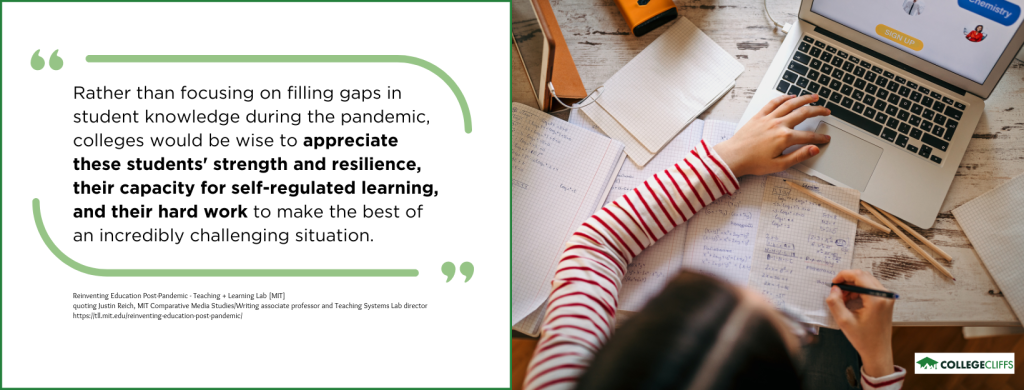10 Post-Pandemic Trends In Higher Education
In this article, we will be covering...
One of the most impactful events in this recent decade, the COVID-19 pandemic was arguably the biggest challenge to the higher education industry, forcing academic institutions to address safety concerns and travel limitations that resulted in disrupted learning.
The disastrous state of affairs caused the removal of face-to-face group instruction from all educational levels, along with s substantial overhaul of the online learning environment. Virtual worlds have since taken over for everything from teaching and learning to graduation ceremonies.
Some years later, the global pandemic has halted, and now, everything is finally normal—or maybe a new normal has begun.
Let’s explore higher education trends that were embraced during the pandemic and are being retained by institutions today.
Focus on Digital Learning

One of the most obvious post-pandemic trends in higher education, digital technology adoption continues to enhance procedures, empower instructors, and put the needs of the students first.
Most universities continue to deliver lectures online through distance learning and digital submissions for those who might find it difficult to attend. Learners have maximized the use of computers, tablets, mobile phones, and laptops for educational purposes.
Virtual Internships
During the pandemic, internships, like classes, were virtual. As they get used to the change, employers are beginning to see the numerous advantages of virtual internships. Hiring from a larger pool of people is one advantage, particularly in cases where physical distance used to be a barrier.
Skill-Based Courses

A trend that emerged in post-pandemic higher education is the focus on skills-based courses and training. Many institutions are shifting gears in their learning instruction: while being brain-smart remains important, what’s even more crucial is to be skilled and street-smart. A skill-based learning program can be ideal for you if you want to go into a new, rewarding profession rapidly.
Career-focused Curriculum
A growing number of educational programs are shifting their focus from theory to practical training in their courses. Although theoretical knowledge and lectures are always necessary, the focus is now geared toward practical learning to set students up for success in the workplace.
Many academic programs are changing their curricula to increase students’ satisfaction with the courses they attend by giving them the impression that their time is valuable and that their efforts will be rewarded once they graduate.
More degree programs are now offering internships, practicums, and opportunities to connect with industry professionals. These are trends that will only increase over time!
Asynchronous Learning Format

While distance learning is becoming common, it’s no longer limited to only offering synchronous formats. The rise of asynchronous learning styles is becoming more familiar for flexible and busy adult learners. An asynchronous method has been adopted by many professors, meaning that there is no predetermined time for students to be in class.
Students can study the material, attend lectures that have been recorded, and complete the assignments whenever it is convenient for them. This learning arrangement provides greater accessibility and opens opportunities for people with hectic schedules or those who just want a different approach to learning than conventional techniques.
Asynchronous education is here to stay and may even be a better way to teach a wide range of disciplines. It’s a fantastic method of teaching classes. These days, a lot of programs combine live and asynchronous learning, allowing students to select the option that best fits their needs.
Emphasis on Non-Traditional Degrees
Breaking free from traditional degrees is a post-pandemic trend in higher education. Employers will persist in spearheading the expanding trend of non-traditional degrees and non-degree education. More than 130 additional businesses now endorse Google’s decision to regard its tech certificates on par with degrees when recruiting. This opens up more opportunities for any kind of learner.
Employers will keep funding programs that offer financial assistance to workers pursuing degrees as part of their education-as-a-benefit initiatives, but almost all of these degrees will be for non-traditional students or totally online courses. The demand for residential 4-year degrees will continue to decline as a result of both of these developments.
Increase in Interactions

While physical classrooms are superior to virtual ones because they allow for more interaction between professors and students, online learning has adapted many strategies to increase socialization and engagement among peers and professors. Teachers continue to incorporate more interactive and collaborative features into their online courses.
Blended learning embraces a range of resources and platforms, such as webinars, podcasts, and websites that promote engagement, sociability, and immersive learning in the post-COVID era of higher education.
AI-Integrated Learning
COVID-19 continues to accelerate the general acceptance and application of AI in higher education. Digital technology has already made it possible for educators to customize each student’s learning experience instead of teaching to one-size-fits-all.
The potential for revolutionizing the educational environment through the incorporation of AI in eLearning is enormous. Artificial intelligence has the potential to improve education, optimize instruction, and empower teachers through customizing learning, intelligent tutoring, content production automation, and robust analytics.
Instructor Empowerment

Post-pandemic, the education industry continues to empower the teaching profession. Educational professionals would lose their audience and witness a decline in grade numbers if they carried on with the same old, routine material and tasks!
The continued success of digital education hinges on the extensive retraining of educators to adopt new perspectives, be flexible in their approach, and facilitate technology-enabled communication between students and teachers.
Diverse and Unique Content
Even if the ideas behind many subjects are mostly the same, educators—including boards, instructors, education assistants, and schools—have been coming up with creative and novel approaches to keep students interested. Lectures no longer work well for most people, in part because people’s attention spans are shorter than they used to be. Engaging in remote or distance learning can present several distractions for both adult and college-age students.
Substituting or enhancing lectures with innovative exercises, stimulating activities, and thought-provoking discussions can improve outcomes for both students and institutions. This is something that is getting more widespread; educational institutions are not only updating their material but also giving careful thought to how best to distribute it and make it engaging for students.
The Education Industry Embracing the Lessons of the Pandemic
- Distance learning and flexible learning models exploded, pushing higher education institutions to address inadequacies in technology, infrastructure, and support networks while bringing attention to digital inequality.
- The higher education sector has grasped the importance of a data-driven approach to curriculum design, as well as predictive analytics and learning analytics.
- Technology-enabled learning settings, interactive learning tools, gamification, and multimedia materials and technologies promote high student engagement, communication, and virtual collaboration.
- Technology fosters inclusion by removing geographical boundaries and opening up education to a larger spectrum of students.

Conclusion
One thing is certain: online education is here to stay, even as COVID-19 is finally put to an end. Even though several studies have long predicted this, the current epidemic is what has caused a seismic shift, forcing students off of campuses and into their homes. Long-term, profound changes are expected to alter the world as you know it drastically. Today’s education is incredibly fragmented, with teachers and pupils juggling entirely tech-based instruction and new standards.
Although there have been sporadic attempts to transition to online learning, the epidemic has forced educational institutions to embrace digital technology head-on and develop innovative teaching methods. In addition to giving students more control over their education, the new educational trends will also shift the role of professors from information providers to facilitators, developing more self-disciplined, autonomous, and tech-savvy students.
